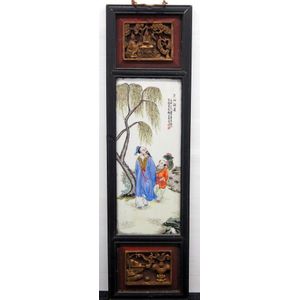Chinese Porcelain Tile with Yan Guang and Young Boy
You must be a subscriber, and be logged in to view price and dealer details.
Subscribe Now to view actual auction price for this item
When you subscribe, you have the option of setting the currency in which to display prices to $Au, $US, $NZ or Stg.
- Republic Period - The Chinese Republic period, also known as the Republic of China period, lasted from 1912 to 1949. It began with the overthrow of the Qing Dynasty in 1911 and the establishment of the Republic of China under Sun Yat-sen. During this period, the country underwent significant political, social, and economic changes, including the adoption of a new constitution, the expansion of civil liberties, and the modernization of the economy. However, the Republic of China period was also marked by political instability, with numerous warlords and factions vying for power and influence, and the country was eventually engulfed in a civil war between the Nationalists and the Communists. The Republic of China period came to an end in 1949, when the Communists emerged victorious and established the People's Republic of China, while the Nationalists retreated to Taiwan where they established a separate government.
- Lacquered Lacquerware - Lacquer is a clear or coloured resin that is obtained from the sap of several species of trees in the genus Rhus, particularly the Rhus verniciflua tree, which is native to China and Japan. The resin is harvested by making incisions in the tree bark and collecting the sap that oozes out.
The sap is then processed and refined through a series of steps, which may include filtration, heating, and chemical treatments. The resulting lacquer is a highly durable and glossy material that is used as a finish for furniture, musical instruments, and other objects.
Lacquer has been used for thousands of years in Asia, where it is valued for its beauty and durability. It is applied in multiple thin layers, with each layer being allowed to dry and harden before the next one is added. The process can take several weeks or even months to complete, but the resulting finish is incredibly hard, glossy, and resistant to scratches and wear.
The lacquer derived from the resin of the Rhus tree has been used for decoration of furniture in several countries in Asia, particularly China, Japan, Korea, and Vietnam. These countries have rich traditions of using lacquer for furniture decoration and have developed unique techniques and styles of lacquer work.
In China, lacquer has been used for furniture decoration for over 2,000 years, and it became a major art form during the Ming (1368-1644) and Qing (1644-1912) dynasties. Chinese lacquerware is known for its intricate carving, painting, and inlay work, as well as its use of bold colours and designs. Lacquer was used to decorate furniture such as cabinets, screens, and chairs.
In Japan, lacquer has been used for furniture decoration for over 1,000 years. Japanese lacquerware is characterized by its simplicity and elegance, and it often incorporates natural materials such as wood, bamboo, and shells. Lacquer was used to decorate furniture such as chests, cabinets, and trays.
In Korea, lacquer has been used for furniture decoration for over a thousand years. Korean lacquerware is known for its restrained and understated beauty, and it often features delicate patterns and designs that are achieved through careful layering and carving. Lacquer was used to decorate furniture such as cabinets, chests, and screens.
In Vietnam, lacquer has been used for furniture decoration for over 2,000 years. Vietnamese lacquerware is known for its vibrant colours and intricate designs, and it often features scenes from daily life, nature, and mythology - Overglaze on Porcelain - Overglaze decoration on porcelain refers to a decorative technique where designs are painted onto a fired and glazed porcelain surface, and then fired again at a lower temperature to fuse the decorative design onto the glaze surface. This technique allows for a wide range of colors and intricate designs that would not be possible with underglaze decoration, which is applied before the glaze is fired.
This item has been included into following indexes:
- Chinese ceramics - ceramic plaques, Chinese 94
- Chinese ceramics, dynasty mark or period - vases, Republic period (1912 - 1949) 432
-
Chinese ceramics, item type
- panels and plaques 422
- tiles 43
Visually similar items

A Chinese porcelain painted tile, Zhushan Artist Wang Qi [1884-1937], inscribed date 1932, signature & two red seals, painted in overglaze enamels with East Han Hermit Yan Guang & a young boy holding a Guqin, the plaque frame has two panels top & bottom in

Three Japanese postcards painted on textured paper, mid 20th century, brightly painted with geisha & a young man with firewood, lime green mount & red frame, 70 x 23 cm

A pair of Chinese painted panels. Large panel featuring birds & famille rose, signed & inscribed upper left and right, 55 x 32 cm

Ink and colour on silk, butterflies in the Flowering Blooms, a Poem, signed by Peiying, flower specimens, Magnolia, cherry blossom, iris and rose (2), 48 x 54 cm
